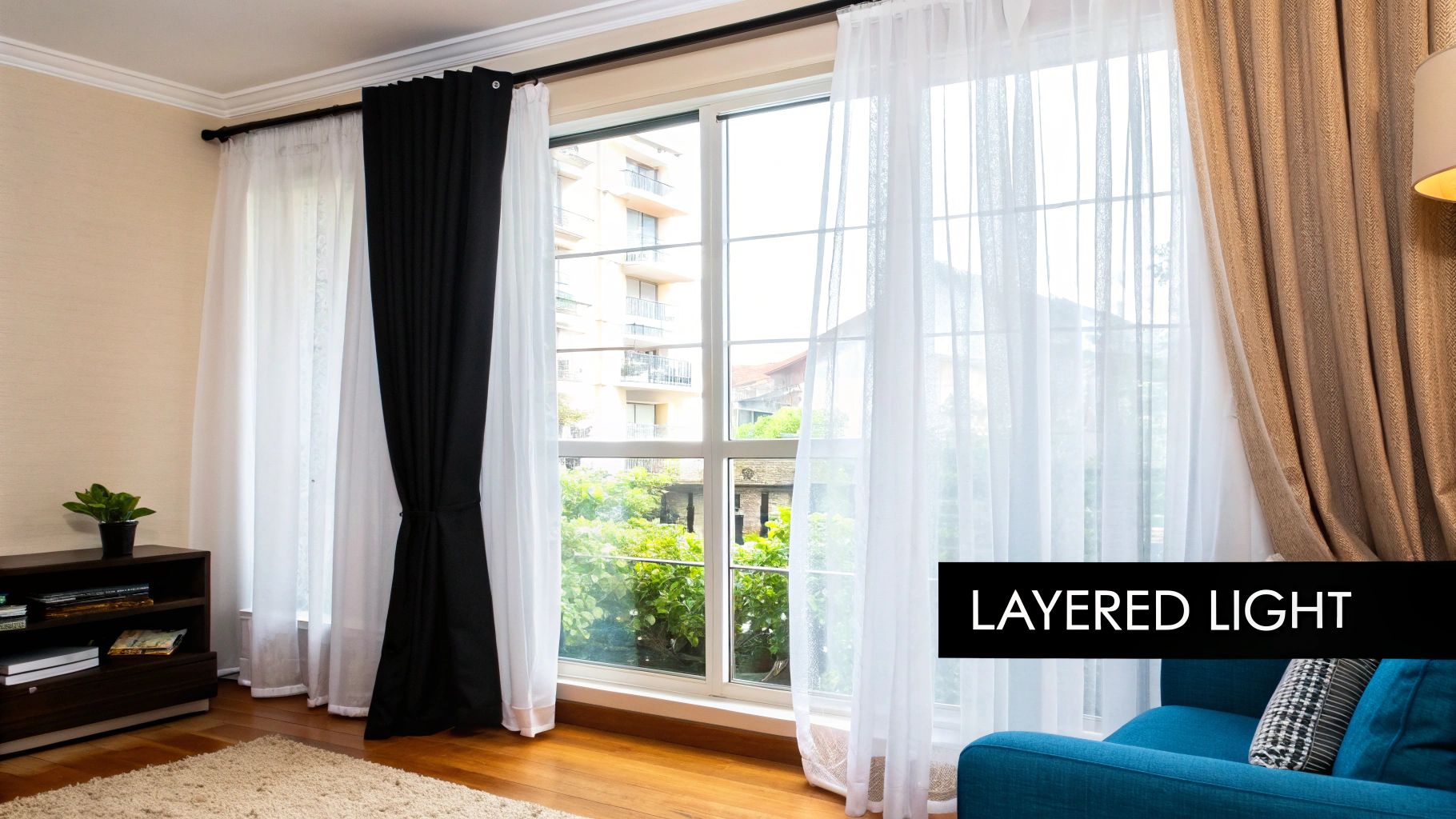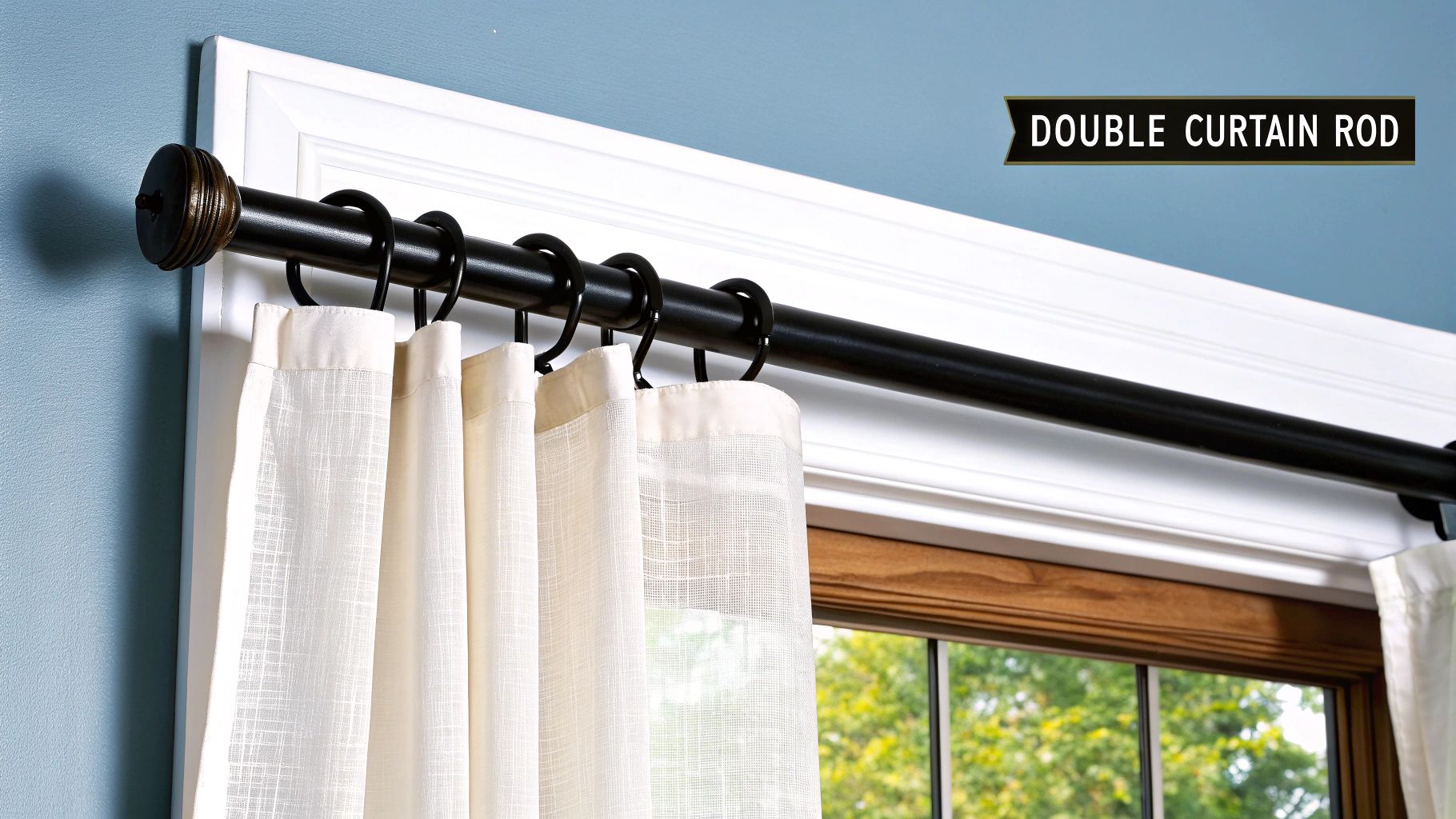
How to Hang Sheer Curtains with Drapes for a Designer Look
Learning how to hang sheer curtains with drapes is a designer secret that instantly elevates any room. It looks luxurious, but the core technique is surprisingly straightforward. The short answer is: you use a double curtain rod. The lightweight sheers hang on the inner rod (closest to the glass) and the heavier drapes go on the outer rod, giving you ultimate control over light, privacy, and style.
In this guide, we'll walk you through everything from choosing the right hardware to the final styling touches, so you can achieve that perfect, professional finish.
Table of Contents
- Why Layering Curtains is a Game Changer
- Choosing the Right Double Curtain Rod
- How to Measure for a Perfect Drape
- Step-by-Step Guide to a Flawless Installation
- Styling Layered Curtains Like an Interior Designer
- Frequently Asked Questions
Why Layering Curtains Is a Game Changer
Ever wonder how interior designers achieve that polished, complete look around windows? It's often the strategic layering of sheer curtains with drapes. This combination isn't just a trend; it's a powerful design tool that adds depth, texture, and unmatched versatility to your space.
The growing demand for flexible and functional window treatments reflects a larger shift in home design. In fact, the global market for curtains and drapes is projected to hit nearly USD 58.5 billion by 2034, driven by our desire for homes that are both beautiful and practical.
Sheers vs. Drapes vs. Both: A Quick Comparison
What makes the combination so special? Let's break down the pros and cons of each option. While sheers or drapes are fine on their own, pairing them is where you unlock your window's full potential.
| Feature | Sheer Curtains Only | Drapes Only | Sheers and Drapes Combined |
|---|---|---|---|
| Light Control | Diffuses harsh light, providing a soft, ambient glow. | Blocks light effectively, great for room darkening. | Ultimate flexibility: soft, diffused light with sheers or complete darkness with drapes. |
| Privacy | Offers daytime privacy, but silhouettes can be visible. | Provides complete privacy day or night when closed. | Best of both: daytime privacy with sheers and total seclusion with drapes. |
| Aesthetic Appeal | Creates an airy, light, and casual feel. | Adds weight, richness, and a formal or cozy atmosphere. | Rich and layered look: adds texture, depth, and a sophisticated, professionally styled feel. |
| Energy Efficiency | Minimal insulation. | Offers good thermal insulation, especially with liners. | Enhanced insulation: the double layer traps air, improving energy efficiency year-round. |
Getting the Perfect Vibe, Day or Night
Combining sheers and drapes gives you an adaptable toolkit for your room's atmosphere, no matter the time of day.
-
Daytime Ambiance: During the day, pull the drapes back and let the sheers diffuse the sunlight. This fills the room with a soft, inviting glow—without the harsh glare. It also helps protect your furniture and floors from direct UV damage.
-
Nighttime Privacy: When evening arrives, drawing the drapes closed provides complete privacy. This also adds a layer of thermal insulation, helping to keep your room cozy in the winter and cooler in the summer.

Insider Tip: I think of sheer curtains as the base layer of an outfit—they provide a constant, soft foundation. The drapes are the statement piece, like a jacket you can change with the seasons or as your style evolves.
The beauty of this method is its adaptability. Whether you want a bright living room or a serene bedroom retreat, learning how to hang sheer curtains with drapes gives you the tools to create the perfect atmosphere.
Choosing the Right Double Curtain Rod

The secret to a beautifully layered window isn't just the fabric—it's the hardware. Picking the right double curtain rod is the most crucial first step. It ensures your curtains hang and operate smoothly and plays a major role in your room's overall style.
Rods vs. Tracks: What's the Difference?
When it comes to hardware for layering, you generally have two main options: a double rod or a double track system.
-
Double Curtain Rods: This is the most common and decorative choice. The setup features two parallel rods held by a single set of brackets. The front rod is typically thicker for heavier drapes, while the back rod holds the lightweight sheers. They come in endless styles and finishes to match your decor.
-
Double Track Systems: Tracks are a more discreet, minimalist option. Curtains glide along carriers inside a channel mounted on the wall or ceiling. They’re fantastic for very wide windows, heavy drapes, or achieving a seamless, floor-to-ceiling hotel look.
Expert Takeaway: A double rod is the go-to for most homes and adds a decorative flair. Opt for a track system if you prefer a minimalist design or are hanging exceptionally heavy fabrics.
Critical Details to Consider Before You Buy
Before you add a rod to your cart, let's review a few key details. Getting these right will save you a ton of frustration during installation.
Material and Finish
The rod's material affects both its look and strength. Metal rods (steel, iron) are workhorses perfect for heavy drapes. Wood rods bring a warm, traditional feel. The finish should complement other hardware in the room—like light fixtures or cabinet pulls—for a cohesive design.
Projection and Return
These terms are crucial for a perfect hang. Projection is how far the rod sticks out from the wall. You need enough space for both curtain layers to hang freely without looking squished. Return is the curved part of the bracket that connects to the wall, which lets the outer drape wrap around the side to block light leaks. If your drapes are bulky, you may need specific curtain rods for heavy curtains.
Support and Brackets
Never overlook weight capacity. A flimsy rod will sag under heavy drapes, creating that dreaded dip in the middle. The rule of thumb is to have a support bracket every 30-36 inches to prevent bowing. Most kits include enough, but for extra-wide windows, add a center support bracket.
How to Measure for a Perfect Drape
Getting your measurements right is the foundation of a stunning window treatment. It’s what separates a professional, custom-fit look from something that feels off. Before you even think about fabrics, let’s nail down the measurements.
The secret is the "high and wide" method. This simple technique makes windows look larger and ceilings feel taller, creating maximum impact when you hang sheer curtains with drapes.
Go High and Wide for a Grand Effect
Instead of mounting your rod right on the window frame, aim higher and wider. This trick creates a powerful illusion of space and lets more natural light in when the curtains are open.
- Height: Position your double curtain rod 4-6 inches above the top of the window frame. This immediately draws the eye upward, giving the room a more spacious feel.
- Width: Extend the rod 6-12 inches beyond the window frame on each side. This allows the curtains to fully clear the glass when opened, so you aren't blocking your view or the light.
Pro Tip: When in doubt, go wider. Having drapes "stack back" onto the wall instead of the glass is the number one trick for making a small window feel grand and intentional.
Choosing the Right Curtain Length
The length of your curtains significantly influences the room's style. After determining your rod placement, measure from the rod down to where you want the hem to end. You have three classic options:
- The Float: Curtains hang about a half-inch above the floor. This clean, modern look is practical for high-traffic areas since the hems won't collect dust.
- The Kiss: The hem just grazes the floor. This is the most popular and tailored option, creating a beautiful, clean line from top to bottom.
- The Puddle: Add an extra 6-10 inches of fabric that pools elegantly on the floor. This luxurious, romantic style works best in formal spaces to add a touch of drama.
For a more detailed breakdown, our complete guide on measuring windows for drapes is your roadmap to getting it right the first time.
Step-by-Step Guide to a Flawless Installation
You've got your double rod and curtains—now for the fun part. This is where your vision comes to life. We'll walk through it step-by-step to ensure your installation is secure, straight, and stress-free.
First, you need to find the wall studs. Anchoring your brackets into studs provides the strongest possible support, which is non-negotiable for heavy drapes. A simple stud finder is your best friend here; it will prevent you from drilling into hollow drywall.
Securing Your Brackets for a Level Look
Once you've marked the studs, position your first bracket, keeping the "high and wide" principle in mind. Use a pencil to mark the drill holes. After marking the first spot, grab a level to draw a faint, straight line across to where the other bracket(s) will go. This simple step is the secret to a perfectly horizontal rod.
With your brackets securely screwed into the wall, you're ready to hang. Remember the golden rule for layering: sheers go on the inner rod (closest to the window), and drapes go on the outer rod.
The Final Hang and Adjustments
- Thread your sheer curtains onto the back rod.
- Slide your drapes onto the front rod.
- Carefully lift and place each rod into its designated slot on the brackets.
- Attach the finials on each end to finish the look and keep the panels from sliding off.
Final Check: Step back and take it all in. Do the curtains hang evenly? Do they just "kiss" the floor as intended? If you need a refresher on the basics, our guide on how to hang curtains properly has even more foundational tips.
Finally, give your curtains a gentle steam to release any wrinkles from packaging. This finishing touch makes a world of difference, giving your new window treatment a crisp, professionally finished look.
Styling Layered Curtains Like an Interior Designer
Your hardware is up and the curtains are hung. Now it's time to style them so they look like they were pulled from a design magazine. This is where we add those final, intentional touches.
The first rule is to ensure your two fabric layers work together, not against each other. It’s all about balance. If you chose drapes with a bold pattern, pair them with a simple, solid-colored sheer. Conversely, if your sheers have a subtle texture, a solid drape will ground the look perfectly.
Creating Fullness and Mood
One of the biggest differences between a DIY job and a high-end look is fullness. For a truly rich, luxurious feel, the combined width of your curtain panels (both sheers and drapes) should be at least twice the width of your window. This ensures beautiful, deep folds when they're closed instead of looking like a stretched-out sheet.
Color is also your secret weapon for setting the mood:
- For a serene, airy vibe: Stick to a similar light, neutral palette for both layers—think ivory, soft gray, or warm beige.
- For a dramatic, cozy feel: Play with contrast. A light sheer paired with a deep, rich drape in navy, emerald, or charcoal is always a showstopper.
Designer Trick: For a seamless, monochromatic look that makes a room feel larger, match the drape color to your wall color.
Finally, don't forget the finishing touches. Elegant metal tie-backs create a classic, formal drape, while a simple drapery wand keeps fabric clean. These small details turn your layered curtains into a true focal point. To bring this level of thoughtful design to the rest of your space, explore principles of sustainable interior design to elevate your home's entire aesthetic.
Frequently Asked Questions
When you're diving into a project like this, a few questions always pop up. Here are answers to the most common ones to help you move forward with confidence.
What is the proper way to hang sheer curtains with drapes?
The proper way is to use a double curtain rod. The sheer curtains hang on the inner rod, closest to the window glass, to diffuse light and provide daytime privacy. The heavier drapes hang on the outer rod, allowing you to draw them for complete privacy and light control.
Which curtains go in front, sheers or drapes?
The heavier drapes always go in front (on the rod closer to the room). The lightweight sheer curtains hang in the back (on the rod closer to the window). This order is essential for the layering system to function correctly, allowing sheers to filter light while drapes can be pulled over them.
Do the sheers and drapes need to be the same length?
Yes, for a polished, professionally styled look, both layers should be the same length. The most timeless and popular style is having the hem just "kiss" the floor. When curtains hang too high, it can make a room feel dated and visually shrink your ceiling height.
Can I hang sheers and drapes on a single rod?
While it's technically possible with special rings, it's not recommended. Using a single rod defeats the purpose of layering because you lose independent control. You can't open your drapes for light while keeping the sheers closed for privacy. A double curtain rod is the right tool for the job.
Ready to create your own beautifully layered window treatments? Explore the wide selection of curtains and hardware at Joey'z Shopping and find everything you need to bring your vision to life. Visit us at https://joeyzshopping.com.
